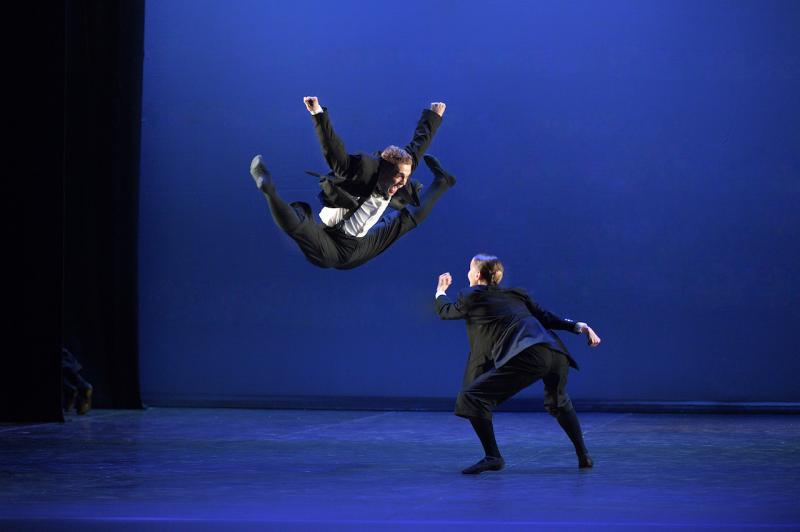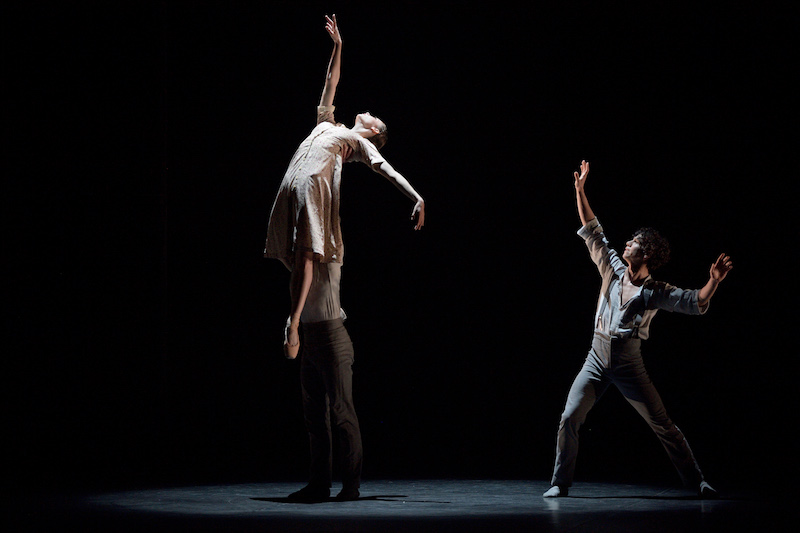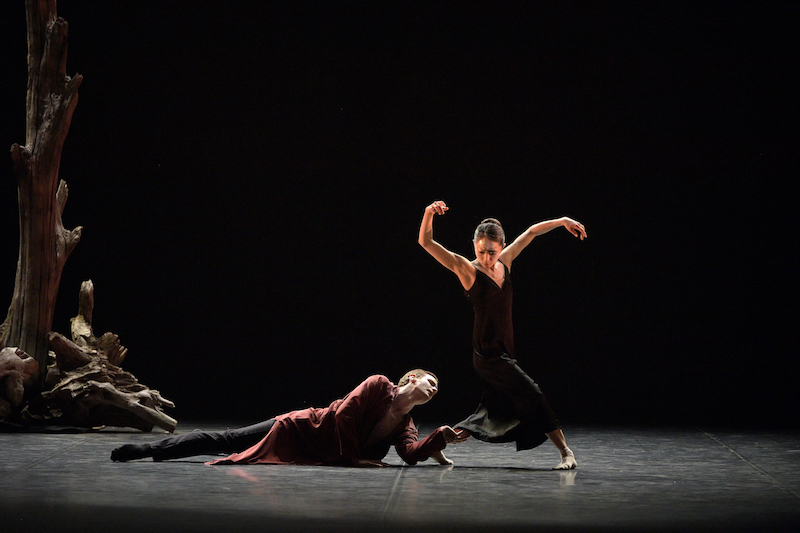Reunion: An Evening with English National Ballet review - back on stage and fabulous | reviews, news & interviews
Reunion: An Evening with English National Ballet review - back on stage and fabulous
Reunion: An Evening with English National Ballet review - back on stage and fabulous
ENB releases all that pent-up energy in its first live showing in 17 months

You could hardly call this back to normal at London’s premier dance house. For a start, there was too much red plush visible in the stalls, not all of it the result of COVID-safe spacing.
The programme was hardly usual either. Five 15-minute works, commissioned to be staged last autumn but initially put out as short dance films, shot under lockdown by young directors from advertising and cinema (and still available online). While choreography regularly makes the journey from stage to screen, the reverse does not. The visible remnant of that process in the live season at Sadler's Wells is the scraps of interview with key dancers and the choreographers, screened in place of a printed programme note. Illuminating, fresh and charming, it's a thing that could catch on. Some of the works fared better on stage, some better on film. Yuri Possokhov's quartet, Senseless Kindness (pictured above), was just as obcure, narratively speaking, either way. It's a big ask to distil a big novel such as Vasily Grossman's Life and Fate, about a Russian family caught up in the Second World War, into a wordless quarter of an hour. But the ballet's extreme fluctuations of passion, tenderness and rage – tracking the moods of Shostakovich's wonderfully acid Piano Trio No 1 played from the pit – were compelling without one's having to know who was doing what to whom and why.
Some of the works fared better on stage, some better on film. Yuri Possokhov's quartet, Senseless Kindness (pictured above), was just as obcure, narratively speaking, either way. It's a big ask to distil a big novel such as Vasily Grossman's Life and Fate, about a Russian family caught up in the Second World War, into a wordless quarter of an hour. But the ballet's extreme fluctuations of passion, tenderness and rage – tracking the moods of Shostakovich's wonderfully acid Piano Trio No 1 played from the pit – were compelling without one's having to know who was doing what to whom and why.
Sidi Larbi Cherkaoui's Laid in Earth, a postscript to the story of Dido and Aeneas, again for four dancers, lost much of its mystery in translation to the stage. On film, the ballet's merging of the Underworld with life on earth is signalled by the encrustation of every surface, including human skin, by fungal decay. At a distance, if those details were there, they failed to register, and the sensuous choreography (Erina Takahashi, pictured below as Dido, with James Streeter as Aeneas, one could only presume) looked stranded amid too much space. Given that Roman myth is hardly common currency these days, wouldn't it have been a good idea to name the characters? I had to guess that the dancer in black scampering on his knees was Cerberus, the three-headed dog, but he could equally have been the Sorceress. It's not un-cool to offer basic information to the audience – it's a no-brainer. There could be no misunderstanding the sheer kinetic joy of Stina Quagebeur's Take Five Blues. Made for a larger group, it takes its cue from Nigel Kennedy's fiddle extemporising on the Paul Desmond standard to push classroom ballet steps into jazz territory, while keeping the women on pointe. Taking a Broadway-chorus loping gait as its base step, the choreography draws on individual strengths to brilliant effect, including multiple fun jumps for the boys and a diamond-sharp set of fouetté turns for Shiori Kase which, had she performed the same in a production of Swan Lake, would have earned its own round of applause. The dancers are all clearly having a ball in this one, and it's infectious.
There could be no misunderstanding the sheer kinetic joy of Stina Quagebeur's Take Five Blues. Made for a larger group, it takes its cue from Nigel Kennedy's fiddle extemporising on the Paul Desmond standard to push classroom ballet steps into jazz territory, while keeping the women on pointe. Taking a Broadway-chorus loping gait as its base step, the choreography draws on individual strengths to brilliant effect, including multiple fun jumps for the boys and a diamond-sharp set of fouetté turns for Shiori Kase which, had she performed the same in a production of Swan Lake, would have earned its own round of applause. The dancers are all clearly having a ball in this one, and it's infectious.
Russell Maliphant's Echoes effectively reduces the blood pressure in what could equally have been titled L'Après-midi d'un bouddhiste zen (perhaps better that it wasn't, though). In other hands, these slow, fluid moves – giving the strange and beautiful impression of the upright human body flowing horizontally – would be soporific, but here the intensity and precision of that flow, and the ever-changing sculptural light effects of video artist Panagiotis Tomaras, rendered me alert to every nuance. I didn't want it to stop.
Last but very definitely not least comes Jolly Folly, by 24-year-old Arielle Smith – a talent whose mentoring by Matthew Bourne (she was his Young Associate Choreographer on Romeo + Juliet, no less) looks to be bearing valuable fruit already. Inspired by the Little Tramp persona of Charlie Chaplin, and driven by the Klazz Brothers' Afro-Cuban covers of classical lollipops, this is another of those pieces whose energy needs to be allowed to let rip live. Boy, does it go at a lick! Not only is Smith's stream of comedic invention impressive, but she shows uncannily mature skill in using clothing to amplify her effects. The flap of all those oversized black DJs is integral to every step.
Yes, of course, it's a marvellous feeling to be back in a theatre auditorium, but frankly I'd have queued to see a piano-playing cat if it was live on stage. What's more gratifying by far is to the find the stage aflame with work like this, and performers in such fine shape.
rating
Explore topics
Share this article
The future of Arts Journalism
You can stop theartsdesk.com closing!
We urgently need financing to survive. Our fundraising drive has thus far raised £49,000 but we need to reach £100,000 or we will be forced to close. Please contribute here: https://gofund.me/c3f6033d
And if you can forward this information to anyone who might assist, we’d be grateful.

Subscribe to theartsdesk.com
Thank you for continuing to read our work on theartsdesk.com. For unlimited access to every article in its entirety, including our archive of more than 15,000 pieces, we're asking for £5 per month or £40 per year. We feel it's a very good deal, and hope you do too.
To take a subscription now simply click here.
And if you're looking for that extra gift for a friend or family member, why not treat them to a theartsdesk.com gift subscription?
more Dance
 'We are bowled over!' Thank you for your messages of love and support
Much-appreciated words of commendation from readers and the cultural community
'We are bowled over!' Thank you for your messages of love and support
Much-appreciated words of commendation from readers and the cultural community
 Like Water for Chocolate, Royal Ballet review - splendid dancing and sets, but there's too much plot
Christopher Wheeldon's version looks great but is too muddling to connect with fully
Like Water for Chocolate, Royal Ballet review - splendid dancing and sets, but there's too much plot
Christopher Wheeldon's version looks great but is too muddling to connect with fully
 iD-Reloaded, Cirque Éloize, Marlowe Theatre, Canterbury review - attitude, energy and invention
A riotous blend of urban dance music, hip hop and contemporary circus
iD-Reloaded, Cirque Éloize, Marlowe Theatre, Canterbury review - attitude, energy and invention
A riotous blend of urban dance music, hip hop and contemporary circus
 How to be a Dancer in 72,000 Easy Lessons, Teaċ Daṁsa review - a riveting account of a life in dance
Michael Keegan-Dolan's unique hybrid of physical theatre and comic monologue
How to be a Dancer in 72,000 Easy Lessons, Teaċ Daṁsa review - a riveting account of a life in dance
Michael Keegan-Dolan's unique hybrid of physical theatre and comic monologue
 A Single Man, Linbury Theatre review - an anatomy of melancholy, with breaks in the clouds
Ed Watson and Jonathan Goddard are extraordinary in Jonathan Watkins' dance theatre adaptation of Isherwood's novel
A Single Man, Linbury Theatre review - an anatomy of melancholy, with breaks in the clouds
Ed Watson and Jonathan Goddard are extraordinary in Jonathan Watkins' dance theatre adaptation of Isherwood's novel
 Peaky Blinders: The Redemption of Thomas Shelby, Rambert, Sadler's Wells review - exciting dancing, if you can see it
Six TV series reduced to 100 minutes' dance time doesn't quite compute
Peaky Blinders: The Redemption of Thomas Shelby, Rambert, Sadler's Wells review - exciting dancing, if you can see it
Six TV series reduced to 100 minutes' dance time doesn't quite compute
 Giselle, National Ballet of Japan review - return of a classic, refreshed and impeccably danced
First visit by Miyako Yoshida's company leaves you wanting more
Giselle, National Ballet of Japan review - return of a classic, refreshed and impeccably danced
First visit by Miyako Yoshida's company leaves you wanting more
 Quadrophenia, Sadler's Wells review - missed opportunity to give new stage life to a Who classic
The brilliant cast need a tighter score and a stronger narrative
Quadrophenia, Sadler's Wells review - missed opportunity to give new stage life to a Who classic
The brilliant cast need a tighter score and a stronger narrative
 The Midnight Bell, Sadler's Wells review - a first reprise for one of Matthew Bourne's most compelling shows to date
The after-hours lives of the sad and lonely are drawn with compassion, originality and skill
The Midnight Bell, Sadler's Wells review - a first reprise for one of Matthew Bourne's most compelling shows to date
The after-hours lives of the sad and lonely are drawn with compassion, originality and skill
 Ballet to Broadway: Wheeldon Works, Royal Ballet review - the impressive range and reach of Christopher Wheeldon's craft
The title says it: as dancemaker, as creative magnet, the man clearly works his socks off
Ballet to Broadway: Wheeldon Works, Royal Ballet review - the impressive range and reach of Christopher Wheeldon's craft
The title says it: as dancemaker, as creative magnet, the man clearly works his socks off
 The Forsythe Programme, English National Ballet review - brains, beauty and bravura
Once again the veteran choreographer and maverick William Forsythe raises ENB's game
The Forsythe Programme, English National Ballet review - brains, beauty and bravura
Once again the veteran choreographer and maverick William Forsythe raises ENB's game
 Sad Book, Hackney Empire review - What we feel, what we show, and the many ways we deal with sadness
A book about navigating grief feeds into unusual and compelling dance theatre
Sad Book, Hackney Empire review - What we feel, what we show, and the many ways we deal with sadness
A book about navigating grief feeds into unusual and compelling dance theatre

Add comment